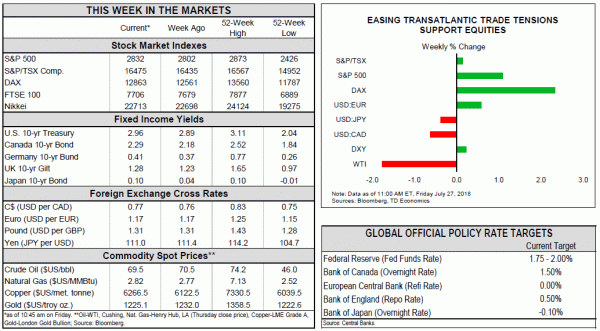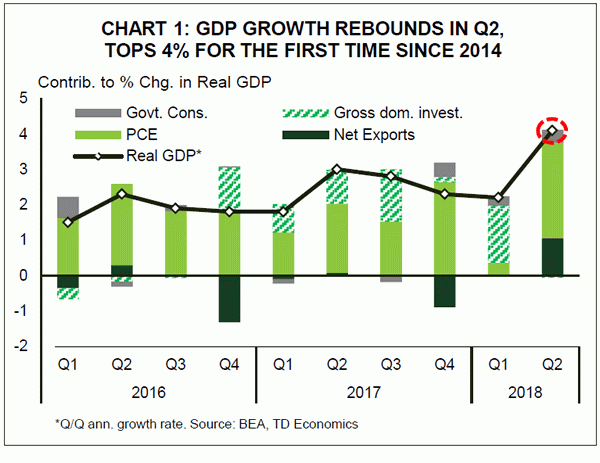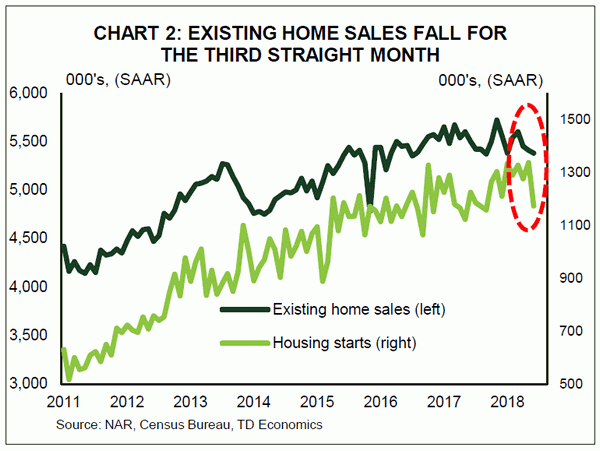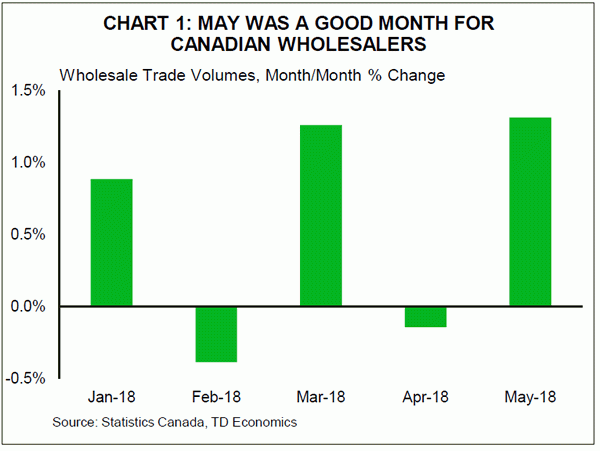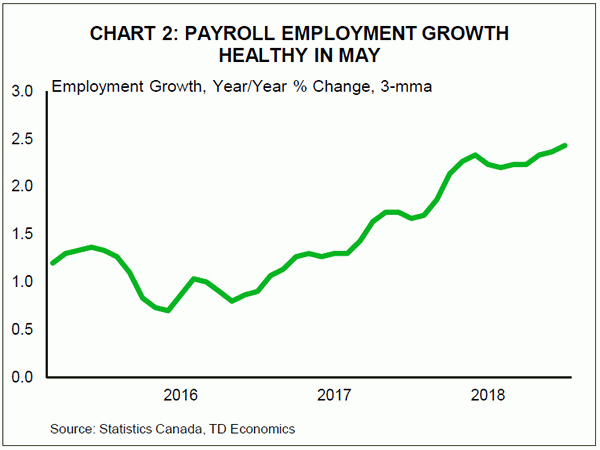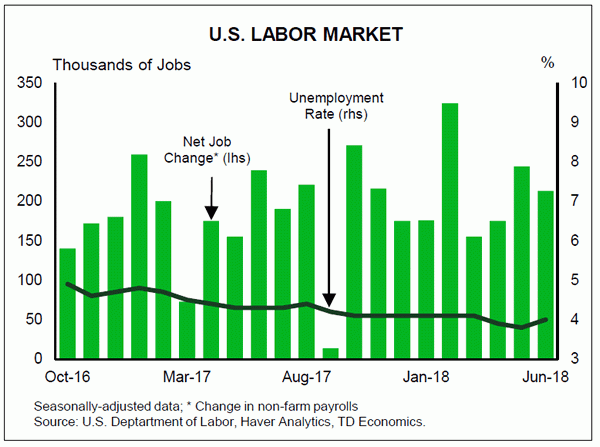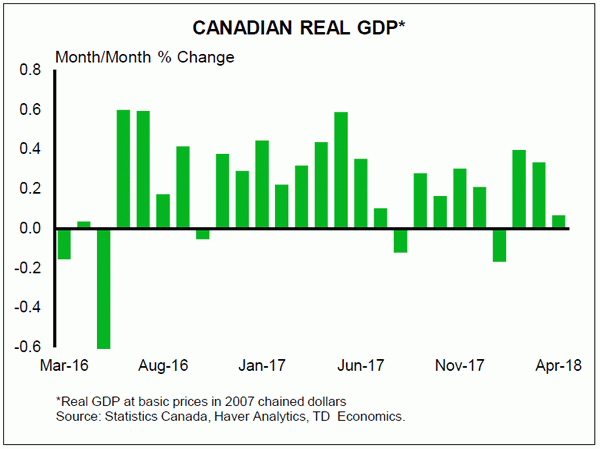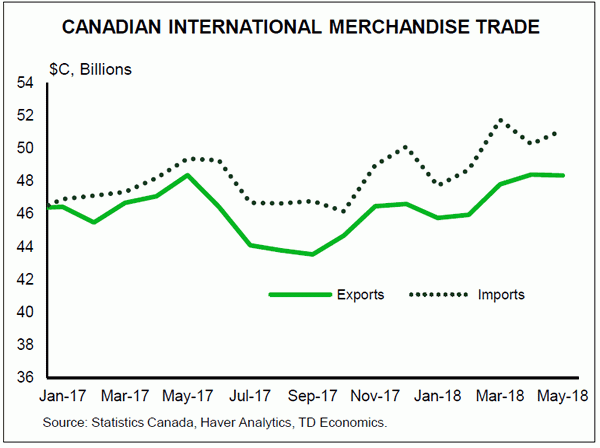U.S. Highlights
- U.S. economic growth topped 4% in Q2 for the first time since 2014. Consumer spending bounced back and resumed its leader status, but non-residential investment (+7.3%) and net exports also provided a helping hand.
- Residential investment remained a soft spot, falling 1.1% in the quarter. Housing data out this week added to the downbeat narrative, with existing home sales extending their losing streak to three months.
- The U.S. and EU struck a truce on trade as they vowed to work together toward zero tariffs on industrial goods. This was welcomed by markets, but trade policy uncertainty and the downside risk that it poses is far from gone.
Canadian Highlights
- Wholesale volumes grew at a brisk 1% pace in May while payroll employment expanded by a healthy 41k. These data points serve to reinforce our view that the economy is on track for near 3% growth in the second quarter.
- The agreement between President Trump and the EU to work on resolving their trade dispute helped to ease fears about looming import levies on Canada’s auto sector. Trump also expressed some optimism around a NAFTA deal, which if reached sooner rather than later, would remove a significant source of uncertainty for Canadian businesses.
- In an interview, Minister Morneau indicated that addressing competitiveness challenges will be a key theme in the fall fiscal update, with the Minister likely to focus on lowering the cost of new investment for businesses.
U.S. – “Terrific” 4% Growth Pace Unlikely To Last
This morning’s GDP report was highly anticipated given that it would confirm if the American economy had indeed shaken off the winter blues. Consensus forecast 4.2% (annualized) growth for the second quarter and the headline print did not disappoint, coming in just shy of that. This release included comprehensive revisions, such as new benchmark data and improvements which aimed to mitigate residual seasonality. As a result, growth in the majority of first quarters over the past decade was bumped up 0.4 ppts on average. Indeed, growth at the start of this year was nudged up 0.2 pp to 2.2%, which made a 4.1% rebound in Q2 even more remarkable.
The details of the report were largely positive, with some exceptions. Consumer spending bounced back and resumed its status as lead driver (Chart 1). But non-residential investment (+7.3%) and net exports also provided a helping hand. The latter contributed a full point to growth, driven by a 9.3% rise in exports. Part of this strength reflected a temporary spike in soybean and core shipments to beat out the imposition of tariffs from China – evidence that tariffs have already acted to distort economic activity. As the one-time factors are expected to reverse, the strong performance last quarter is unlikely to be repeated this year. But, growth is still expected to remain solid at near 3% in the second half of 2018.
One sore spot in today’s GDP report was residential investment, which fell 1.1% – the second consecutive decline. Housing data out this week affirmed the downbeat narrative. Existing home sales fell 0.6% (m/m) in June, extending the losing streak to three months, despite a slight increase in inventories. The drop joined last week’s tumble in housing starts (Chart 2), and a pullback in volatile new homes sales rounded off the sour data for June.
The housing market is likely to continue to face headwinds on both the supply and demand side ahead. A tightening labor market and rising incomes should continue to buoy buyer interest despite rising prices and higher interest rates. But, bigger challenges on the supply side, such as rising material costs and labor shortages, point to no quick turnaround for inventories. With supply likely to remain a limiting factor, gains in housing activity are anticipated to be gradual. This trend is likely to slow the recovery in the homeownership rate which rose to 64.3% in Q2, up 1.4 pp from its 2016 trough.
On the trade front, tensions between the U.S. and the EU simmered down this week as they agreed to work together toward zero tariffs on industrial goods. In addition, both parties agreed to refrain from imposing further tariffs, while the EU would increase the purchase of U.S. soybeans and LNG. The truce is certainly a step in the right direction and was welcomed by markets. But, we caution against reading too much into this. Contentious issues, such as food and environmental standards, suggest that tensions are likely to make a comeback. What’s more, the ceasefire with the EU gives the U.S. more scope to focus its trade efforts on China, which could ramp up tensions with the Asian giant.
Canada – NAFTA, Competitiveness Issues Back in Focus
It was a relatively light week on the economic data calendar, with a few secondary releases providing a last look at activity ahead of next week’s GDP release for May. Wholesale volumes advanced at a brisk 1% pace during the month (Chart 1), thereby erasing April’s modest drop.
Canada’s other labour market survey (known as the SEPH) was released and also brought a dose of good news. This indicator is somewhat lagged and not as closely followed by financial markets as its more timely LFS counterpart, although it still provides important detail on the state of Canadian labour markets.
According to the SEPH, job growth was strong in May (Chart 2), with payrolls expanding by a healthy 41k – about double the long-term average. This compares favourably to the LFS, which reported an 8k job gain (once agricultural and self-employment is stripped out to make the two surveys more comparable). Hourly earnings also posted a solid gain during the month.
Ultimately, the flow of data released this week reinforced our forecast that GDP likely grew at robust 0.4% m/m in May, placing the economy well on track for 3% growth in the second quarter. However, it likely did little to move the needle for the Bank of Canada, who also expect near 3% growth.
In addition to the recent signs of economic vigour, the Canadian dollar and bond yields were bid higher on an improved tone from the U.S. administration around trade policy. The trade agreement struck by President Trump and the EU at mid-week, which suspended the threat of auto tariffs on the EU, eased fears about looming import levies on Canada’s auto sector. Further, President Trump also expressed some optimism around a NAFTA deal, albeit with Mexico before Canada, though Canadian and Mexican dealmakers still appear to favour a three-way pact. All told, the renewed push ahead on trade talks offers some hope that an agreement could be reached sooner rather than later, which would remove a major source of uncertainty for Canadian businesses.
Another risk to Canada’s medium-term outlook stems from its eroded competitive position versus the U.S. in the wake of the latter’s sweeping tax reforms enacted late last year. To that end, in an interview this week Finance Minister Morneau gave a preview of the upcoming federal fiscal update set to be released late in 2018.
In his interview, Morneau noted that competitiveness challenges were a key theme shaping the budget update while other areas of focus include the NAFTA renegotiation and the government’s recently purchased Trans Mountain pipeline. On the competitiveness front, the Minister indicated that he was more focused on “lowering the cost of new investment”, as opposed to broad-based cuts in the corporate rate. This likely reflects the government’s desire to keep the cost down of any forthcoming package. Based on this signaling, a move to match the US to full expensing of capital equipment is in play.
U.S.: Upcoming Key Economic Releases
U.S. Employment – July
Release Date: August 3, 2018
Previous: 213k, unemployment rate 4.0%
TD Forecast: 175k, unemployment rate 3.9%
Consensus: 185k, unemployment rate 3.9%
We expect payrolls to slow to 175k as surveys signal a pullback below 200k. We expect the unemployment rate to slip to 3.9% as a jump in unemployed workers corrects, and look for a benign 0.2% rise in wages, keeping the y/y pace at 2.7%. Earlier in the week Q2 ECI will be eyed and we expect a 0.7% rise, pushing y/y growth only marginally higher to 2.8%.
Canada: Upcoming Key Economic Releases
Canadian Real GDP – May
Release Date: July 31, 2018
Previous: 0.1% m/m
TD Forecast: 0.4% m/m
Consensus: 0.3% m/m
TD looks for industry-level GDP to rise by 0.4% m/m in May on the heels of a broad pickup in activity data. Goods output will benefit from energy and a rebound in manufacturing sales while utilities will act as a headwind on a return to seasonal temperatures after cold weather saw a sharp rise in electricity output for April. Residential construction is also expected to weigh modestly on growth, though a surge in June housing starts suggests a rebound is right around the corner. On the service side we look for a broad advance in output, with retail sales and food services benefitting from the return to normal weather. This would leave Q2 growth tracking near a 3% pace, slightly above Bank of Canada projections.
Canadian International Trade – June
Release Date: August 3, 2018
Previous: -$2.77bn
TD Forecast: -$2.40bn
Consensus: -$2.20bn
TD looks for the trade deficit to narrow to $2.4bn in June, with both exports and imports higher on the month. A rebound in motor vehicles will drive export growth though metals will provide a partial offset due to the recently introduced steel and aluminum tariffs, which affect roughly $1.5bn in exports per month. Energy exports will also be affected by another shutdown in the oil sands, though this will have a larger impact in July. On the other side of the ledger, imports should benefit from a rebound in retail activity and auto production, after disruptions at a major parts supplier weighed on the latter in May.




